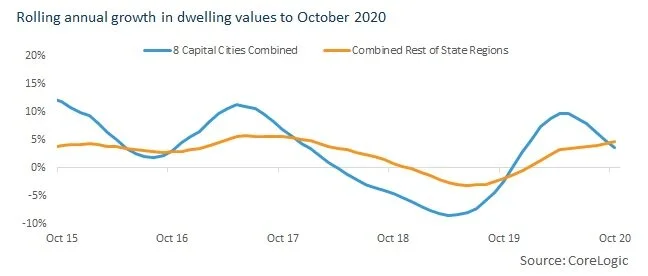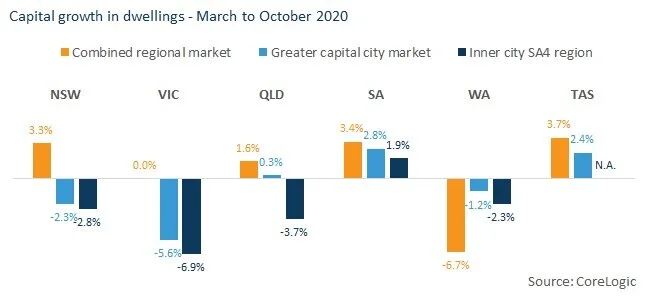Is COVID-19 leading to a regional housing boom?
/Amidst the tumultuous times of the current COVID-19 pandemic, we have seen numerous changes in the economy. Unemployment is at a record high, yet there has been a surge in the property market as people move to take advantage of lowering interest rates.
But rather than looking for properties closer to urban areas, housing market data has indicated that there is a rising demand for properties in regional markets of Australia.
CoreLogic has reported that, for the largest capital cities, rental value increases are positively correlated with greater distance from the CBD. The latest CoreLogic indices show that growth across regional housing markets is higher than the capital cities in both quarterly and annual terms.
We can see this trend reflected in the rolling annual change in dwelling values across the combined regional market in comparison with the combined capital cities market, as shown on the chart below.
While values across the combined regional market increased 4.8% over the year, values across the combined capital cities market only increased by 3.7%.
We have not seen the rate of annual change in combined regional dwellings outpace the capital cities since October 2019, which is when the largest capital cities were experiencing the end of a downturn.
Since the COVID-19 pandemic hit, values across the combined regional areas have increased 1.7% in comparison to the value of combined capital cities falling by 2.3%. The chart below shows the same trend across all the states except Western Australia.
Inner-city markets are showing relatively weak performance in every state. This is due to the effects of the pandemic, as these areas have generally seen greater housing demand from renters – especially those from overseas – and those working in industries negatively impacted by COVID-19.
However, we must consider that these regional areas have outperformed capital cities in the past, due to cyclical patterns. Capital city markets have higher volatility, resulting in higher returns during upswings and deeper declines during downswings. Because of this, we must not be quick to assume that structural shifts caused by the pandemic are behind this incline in regional areas.
Additionally, this hypothesis is not supported by sales data, as it has not highlighted consistent trends in demand. In the three months before October, CoreLogic modelled estimates suggested the growth rate in sales was 10.9% across regional NSW in comparison to 12% across Sydney. But it is difficult to measure demand through sales data, due to high volatility as a result of social distancing restrictions.
Provisional data from the ABS shows internal migration patterns for Australia at the greater capital city and regional level during the first few months of the pandemic. Internal migration tracks the movement of people from one part of Australia to another.
Provisional data from the ABS has shown internal migration patterns during the first few months of the pandemic. In the June quarter, net loss across the combined capital cities was a record low of 10,500 people. This shift from people to regions likely contributed to regional housing markets performing better.
However, internal migration from capital cities has been negative for over a decade. Net internal migration did trend lower since early 2015 as the largest cities became less affordable. Then when housing prices peaked and trended lower, internal migration trends reversed, suggesting that affordability drove people to regional Australia even before COVID-19, which only amplified this trend.
As stage 2 restrictions eased, we saw migration trends shift away from dense cities, as in Melbourne almost a net of 8,000 people left for regional Victoria. Yet, this is also in some part due to affordability, as intrastate departures from Melbourne had already trended up in correlation with capital city prices from 2017.
In summary, a combination of housing and population data indicates that COVID-19 has increased movements to regional Australia, although this trend has previously been driven by the lack of affordability in capital cities. It is a combination of these two factors that have led to the current interest in regional housing.
References
Owen, E. (2020). Is a structural shift in housing demand leading to a regional housing boom? CoreLogic.
Dabu, B. (2020). Will COVID-19 lead to a regional housing boom? Smart Property Investment.










